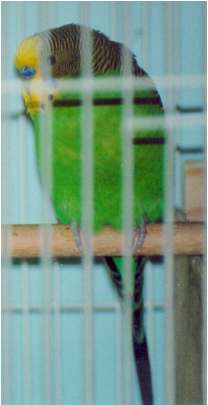Blue budgies also come in three different shades: skyblue, cobalt blue, and mauve, with each one being darker than the one before it. Similarly, grey budgies come in light grey, medium grey, and dark grey.
Those are the names of the colors as they are used by budgie people. Maybe the folks at Crayola have a different idea as to what those color names mean. Photos (especially mine) may not show the accurate colors, so I've made the chart below to show you the different colors.

light green, dark green, olive green
skyblue, cobalt blue, mauve
light grey, medium grey, dark grey
Below are photos of budgies in the three different shades of blue.

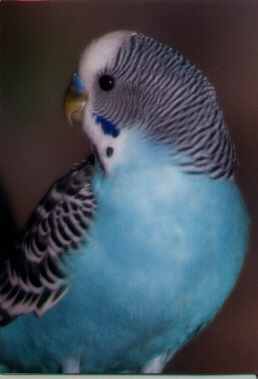
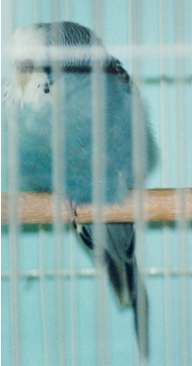
Wow! We've learned about dominant and recessive pieds, opalines, cinnamons, lutinos and albinos, three shades each of green, blue and grey..... what else can there be? Lots...
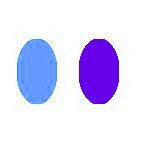 Another color is violet. Violet is a gene that intensifies and deepens the blue color on birds that have blue. It's not so impressive except on cobalt blue birds. It turns a cobalt blue into a visual violet. To the left are the two colors beside each other. The cobalt blue is on the left; visual violet is to its right. Visual violets are the purple budgies.
Another color is violet. Violet is a gene that intensifies and deepens the blue color on birds that have blue. It's not so impressive except on cobalt blue birds. It turns a cobalt blue into a visual violet. To the left are the two colors beside each other. The cobalt blue is on the left; visual violet is to its right. Visual violets are the purple budgies.
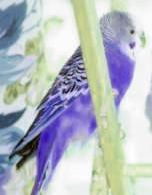
 To the left are two pictures of visual violet budgies. I have adjusted these pictures so that the violet color on the birds is as accurate as possible.
To the left are two pictures of visual violet budgies. I have adjusted these pictures so that the violet color on the birds is as accurate as possible.
The opaline bird looks more purple for two reasons. First, its color is lighter. Opalines sometimes look lighter in color, a little. Second, it is opaline, which means it has no black markings on its back, so we can see its violet color on its back. Light hits the top side of the bird a little differently than it hits the under side of the bird, because lights are usually overhead. Thus, in most lights, an opaline violet will seem a tad more purple than a non-opaline violet.
So with a little trick of the light, you can turn a bird more purple. Well, here's the kicker: birds don't actually have any BLUE pigment at all. All this beautiful blue color comes from BLACK pigment! Each feather has a layer that bends the light, like a prism, to make the black pigment appear blue.

Blue budgies normally have white faces, and green budgies have yellow faces. But there are some blue budgies with yellow faces, as well as some grey budgies with yellow faces. These are called (of course!) Yellowfaces. There are different types of yellowface genes and they make different looking birds. A Type 1 yellowface is a blue (or grey or pied, etc.) bird with a regular blue (or grey or pied, etc.) body and a yellow face. Ok, that one is straightforward.
On the other hand, a Type 2 yellowface is a blue (or grey or pied, etc.) bird with a yellow face and a body that has a light yellow cast over the regular color.
Thus, a skyblue Type 1 yellowface would look skyblue with a yellow face. A skyblue Type 2 yellowface would look aqua blue-green colored with a yellow face. Below, the first two pictures are of two different birds. The third picture is the same two birds, together. Both birds are skyblue Type 2 yellowfaces. How do I know they are yellowface skyblues, and not light greens? By the intensity of the color. Yellowface makes a softer green tint than a truly green bird has.
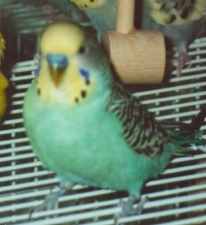
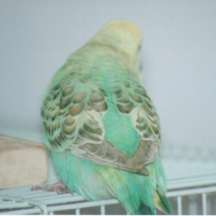

In contrast, here is a picture of a cobalt blue Type 1 yellowface. Notice that this bird appears blue, not greenish:
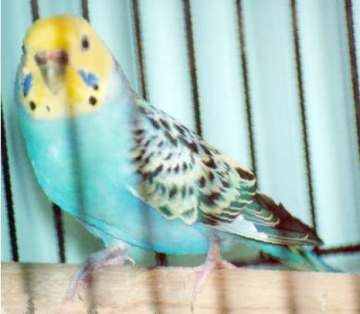
Now, time for a pop quiz! 1.)What is the sex of this bird? 2.)And what is that pattern of markings called? (Answers on page four...)
Take me to educational budgies, page 4.
Take me to Nan & Flock Homepage
This page hosted by ![]() Get your own Free Home Page
Get your own Free Home Page
